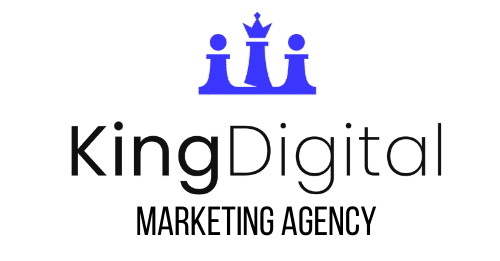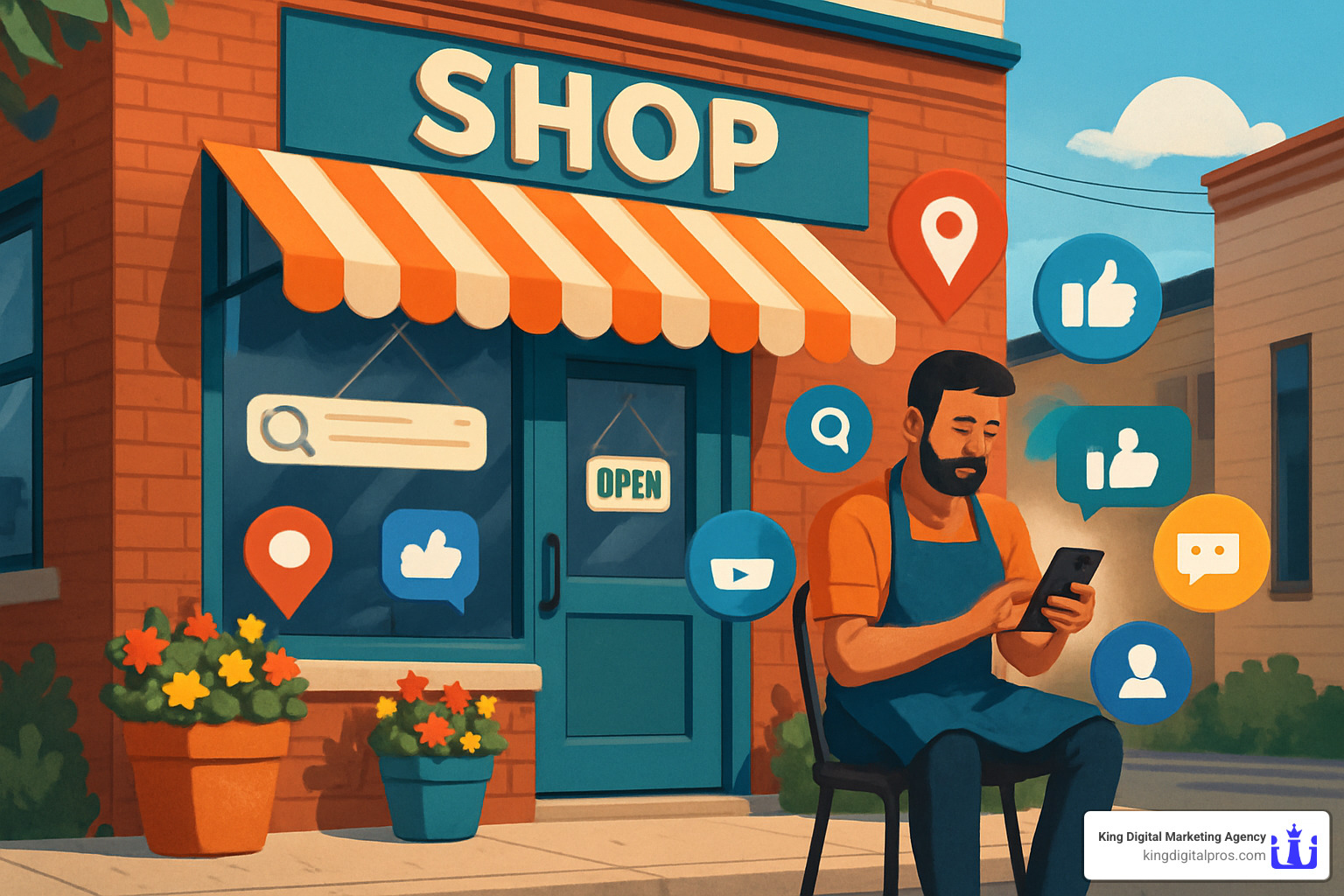Why Local Business Online Marketing is Critical for Your Success
Local Business Online Marketing is the strategic use of digital channels to attract customers within your specific geographic area, focusing on search engines, social media, and online directories to drive foot traffic and local sales.
Quick Start Essentials:
- Claim your Google Business Profile – 75% of local searchers visit businesses within 24 hours
- Optimize for “near me” searches – Nearly half of all Google searches are local
- Collect and respond to reviews – 88% of consumers trust online reviews as much as personal recommendations
- Ensure mobile-friendly website – 59% of mobile users visit businesses the same day they search
- Use local keywords – Target neighborhood names and local landmarks in your content
The numbers tell a compelling story. 85% of all transactions still happen in local stores, yet customers find these businesses online first. When someone searches for “best pizza near me” or “plumber in downtown,” they’re not just browsing – they’re ready to buy.
This shift means your traditional advertising budget now needs to work harder online. Google’s local map pack shows just three businesses for most searches, making visibility more competitive than ever. But local businesses have advantages that national chains can’t match – personal service, community connections, and the ability to respond quickly to neighborhood needs.
I’m Bernadette King, founder of King Digital Marketing Agency, and I’ve helped dozens of franchise owners and small businesses transform their digital presence through targeted Local Business Online Marketing strategies.
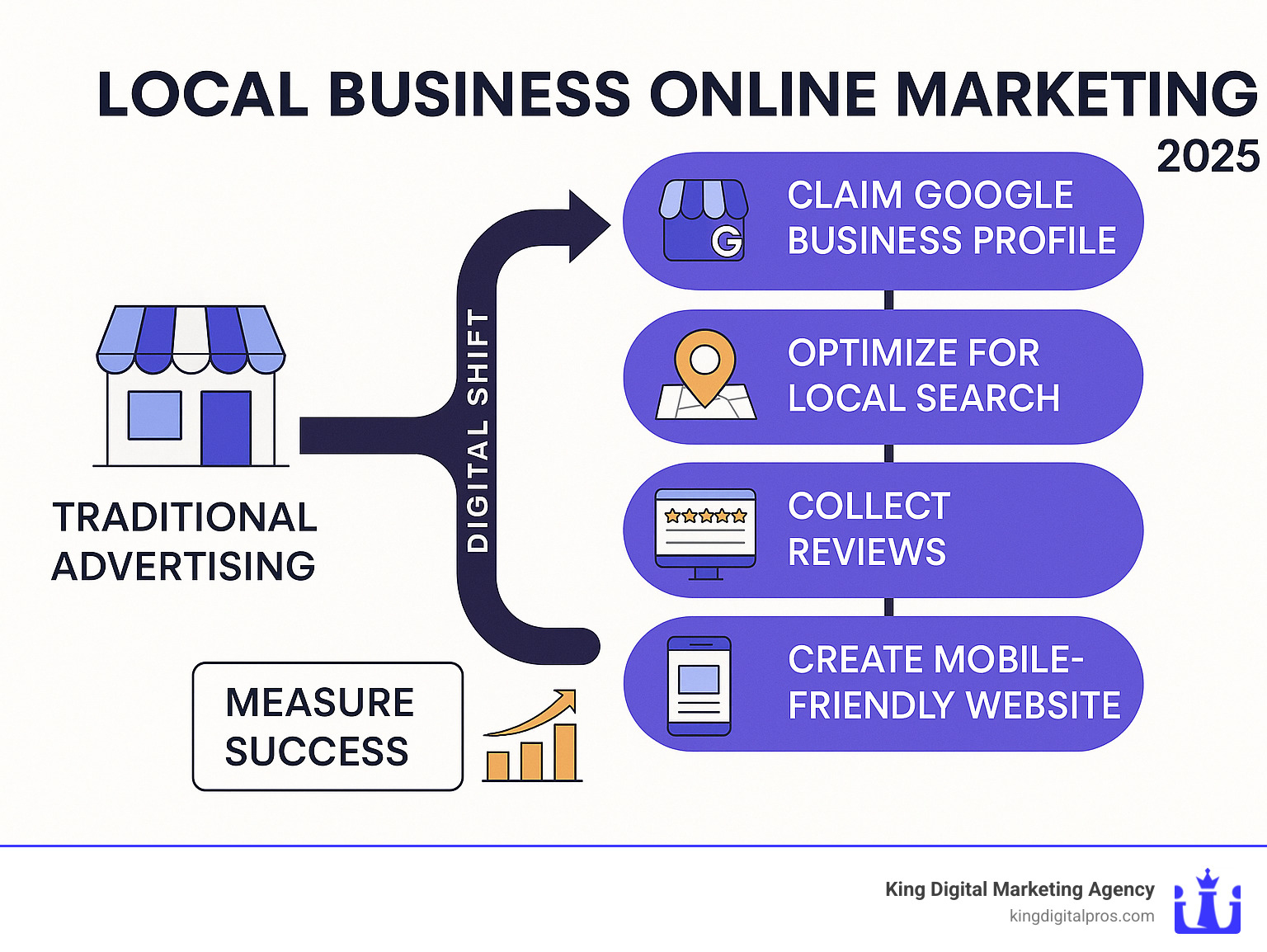
Local Business Online Marketing Explained
Local Business Online Marketing is your digital storefront that works 24/7 to attract customers from your neighborhood. Unlike traditional marketing that casts a wide net, local marketing focuses on people who are already walking toward your door.
The magic happens when someone types “coffee shop near me” into their phone. They’re not browsing for fun – they need their caffeine fix right now. This is completely different from someone searching “best coffee brands” who might just be curious.
Geo-targeting makes this possible. Google’s algorithm looks at where someone is standing when they search, then shows them the most relevant businesses within walking or driving distance.
Mobile phones changed everything. People expect instant answers to location-based questions while they’re out and about. The map pack – those three businesses that show up with a little map at the top of Google results – captures most of the clicks.
Digital vs. Local: Key Differences
Regular SEO is like trying to be heard in a crowded stadium. Local SEO is more like being the loudest voice in your neighborhood coffee shop – much more manageable and effective.
The search intent tells the whole story. When someone searches “home improvement ideas,” they’re probably daydreaming. But “emergency roof repair near me” means they’re dealing with a leak right now and need help fast.
Radius advertising becomes your secret weapon. Instead of competing with every business in the country, you’re focusing on customers within a 10-mile radius who can actually visit your location.
Why Going Local Online Matters
The numbers don’t lie: 75% of people who search for local businesses visit within 24 hours. These aren’t casual browsers – they’re ready-to-buy customers.
Local marketing builds something national chains struggle with: genuine community trust. When customers see you sponsoring the little league team or helping with the annual food drive, they develop emotional connections that turn into lifetime loyalty.
According to research from Google’s local search studies, local businesses that maintain strong online visibility see significant increases in foot traffic and sales conversions.
Local Business Online Marketing Roadmap
Success requires six key elements working together:
Your website needs to work perfectly on mobile phones and load fast. Your business listings should have identical information across Google, Yelp, and other directories.
Review management requires a systematic approach to earning positive feedback. Local SEO involves optimizing your content for location-based searches.
Your social media presence should focus on engaging with your local community. Finally, analytics tracking helps you understand which online activities actually drive foot traffic and phone calls.
Foundations for a Smooth Offline-to-Online Transition
Making the leap from traditional advertising to Local Business Online Marketing doesn’t have to feel overwhelming. Think of it like renovating your store – you wouldn’t start painting before fixing the foundation.
Your digital infrastructure comes first. Secure a domain name that matches your business name, invest in reliable hosting, and ensure your website loads quickly on mobile devices. Your website is your digital storefront, and first impressions count for everything.
NAP consistency is crucial – that’s Name, Address, and Phone number, and it needs to be identical everywhere online. Google’s algorithm cross-references your business information across hundreds of sites. One tiny discrepancy can hurt your local rankings.
Your brand visuals need to work harder online. That logo that looked great on business cards might be unreadable on a smartphone screen. Consistency builds trust, and trust drives local sales.
Step-by-Step Checklist
Week one is all about planning – define your target area, research local competitors, and set a realistic budget. Most small businesses should plan for $1,000-5,000 to get properly established online.
Weeks two and three focus on technical setup. Register your domain and hosting, install WordPress, and set up Google Analytics. If technology isn’t your strength, this is where many business owners wisely invest in professional help.
Week four brings everything together with content creation and local listings. Write pages that speak to your specific neighborhoods and claim your Google Business Profile.
| Setup Option | Time Investment | Cost Range | Best For |
|---|---|---|---|
| DIY Approach | 40-60 hours | $500-2,000 | Tech-savvy owners with time |
| Agency Setup | 2-4 hours oversight | $2,000-5,000 | Busy owners wanting professional results |
| Hybrid Model | 10-20 hours | $1,000-3,000 | Owners wanting to learn while getting help |
Claim & Optimize Your Google Business Profile
Your Google Business Profile is like having a prime storefront location on the busiest street in town – except it’s free. This single listing appears in map searches and influences your local rankings.
Start by claiming your listing through Google Maps. The verification process might take a few days, but it’s worth the wait. Once verified, complete every single section. Businesses with complete profiles receive 70% more clicks than incomplete ones.
Photos make or break your first impression. Upload high-quality images of your storefront, interior, products, and team. Businesses with photos receive 42% more requests for directions and 35% more website clicks.
Keep your hours updated religiously. Nothing frustrates potential customers more than driving to a closed business. Use Google Posts to share updates, promotions, and local news.
More info about Google Business Listing Help
Build Trust with Reviews & Reputation
Online reviews function as digital word-of-mouth recommendations. With 88% of consumers trusting online reviews as much as personal recommendations, your reputation management directly impacts your revenue.
Be systematic about earning reviews. Train your team to mention reviews during positive customer interactions. Send follow-up emails after successful projects with direct links to your Google Business Profile.
Response etiquette reveals your character to potential customers. Thank reviewers by name for positive feedback. For negative reviews, respond professionally and empathetically. Acknowledge the concern, apologize when appropriate, and offer to resolve the issue offline.
Social proof extends beyond star ratings. Showcase customer testimonials on your website, share positive reviews on social media, and include review snippets in your email signatures.
More info about Reputation Management Services
Winning Tactics to Drive Local Traffic & Sales
The beauty of Local Business Online Marketing lies in its variety. But trying to master everything at once is a recipe for burnout. Pick one or two tactics that align with your strengths and customer preferences, then expand gradually.
Local SEO: Ranking in the Map Pack
Local SEO is your digital foundation – it keeps working for you 24/7 without the ongoing costs of paid advertising. The ultimate prize is landing in Google’s map pack, those three coveted spots that appear with map pins for local searches.
Citations are like digital references for your business. Every time your business name, address, and phone number appear together online, you’re building credibility with search engines. Submit to major directories like Yelp and Yellow Pages, plus industry-specific platforms.
Service area pages work incredibly well for businesses serving multiple neighborhoods. Create dedicated pages for each area you serve, incorporating local landmarks and neighborhood-specific keywords.
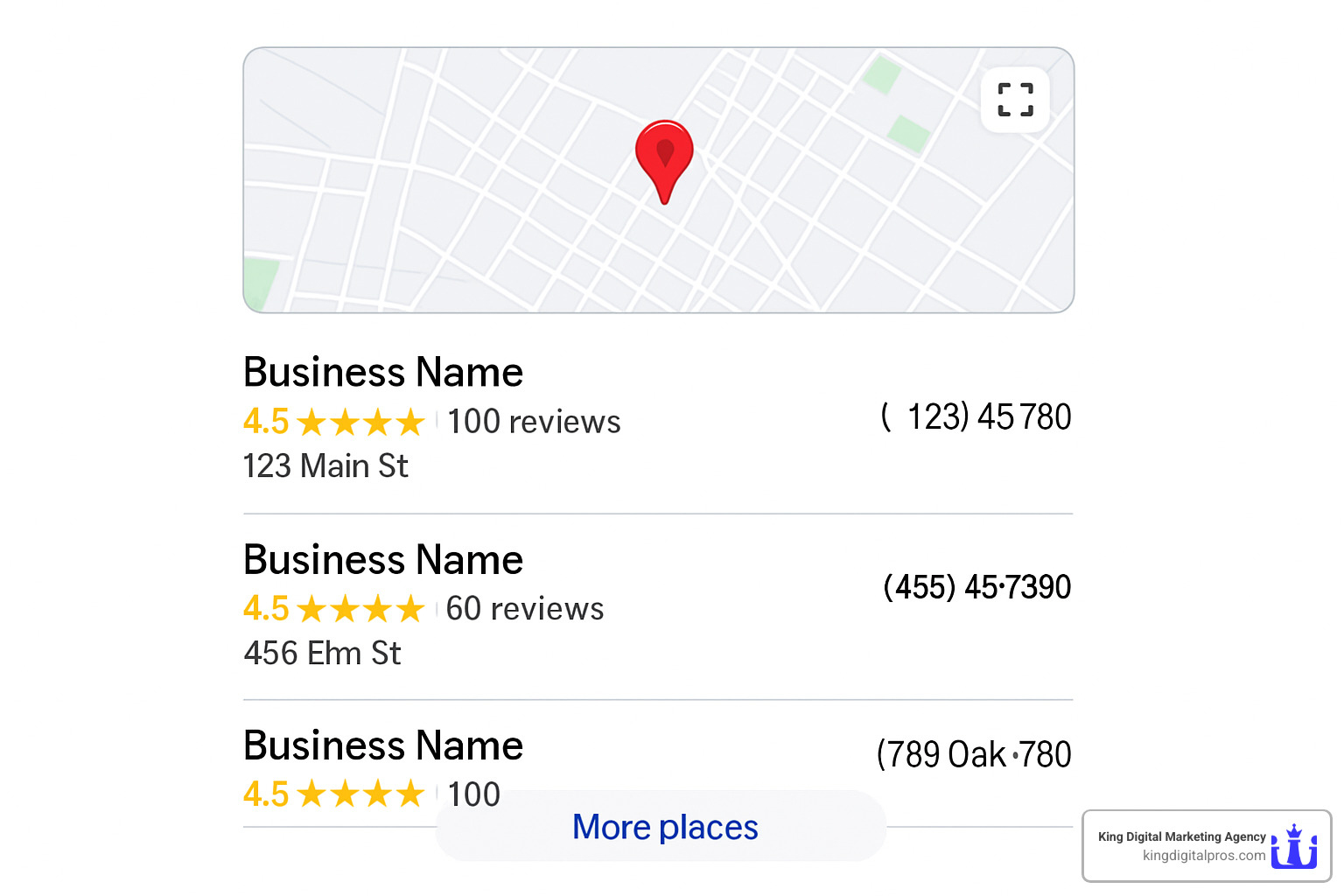
Paid Visibility: Google Local Service Ads & PPC
Google Local Service Ads operate on a pay-per-lead model that makes financial sense for most local businesses. You only pay when someone actually contacts you through the ad.
The Google Guaranteed badge that comes with these ads is marketing gold. Google vets participating businesses through background checks and insurance verification, then backs your work with their guarantee.
Traditional PPC advertising works beautifully for local businesses when set up correctly. Use radius bidding to focus your budget where it matters most. Ad extensions become your secret weapon – include your phone number, address, business hours, and customer reviews right in your ads.
More info about Google Local Service Ads
Social Media for Neighborhood Engagement
Social media for local businesses is completely different from what big brands do. Focus on genuine community connections that translate to actual customers walking through your door.
User-generated content works like magic for local businesses. When customers share photos of your products or tag your location, they’re providing authentic testimonials that money can’t buy.
Geo-hashtags help you connect with neighbors who might become customers. Use neighborhood names, local landmarks, and city-specific tags that locals actually search for.
Direct message support has become as important as answering your phone. Many customers prefer messaging over calling. Respond quickly to questions about hours, services, and availability.
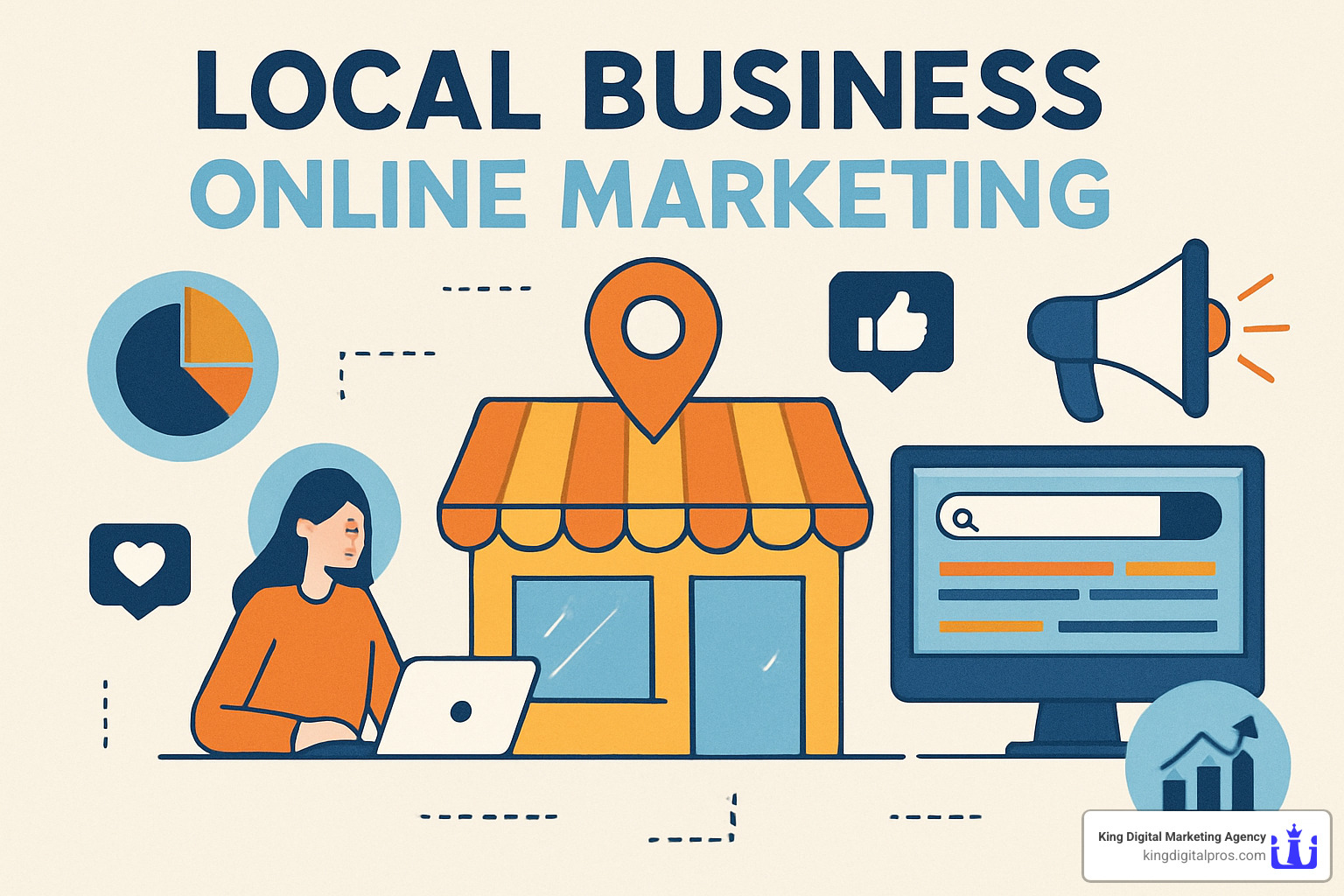
More info about Social Media Advertising
Email & Content to Retain Your Community
Email marketing for local businesses should feel like getting updates from a friendly neighbor. Segment your email list by location, purchase history, and interests to deliver content that actually matters to each subscriber.
Local newsletters consistently outperform generic promotional emails. Share community news, highlight local events, feature customer spotlights, and include exclusive offers for subscribers.
Content marketing should address the specific concerns of your local market. This locally-relevant content attracts customers while establishing your expertise.
Coupon codes and exclusive offers drive immediate action from email subscribers. Track redemption rates carefully to measure your email effectiveness.
Measuring Success & Continuous Improvement
The real magic of Local Business Online Marketing happens when you can see exactly how your online efforts translate into ringing phones, packed parking lots, and growing sales. Unlike old newspaper ads, digital marketing gives you crystal-clear insights into what’s working.
Measuring local marketing success isn’t just about website clicks or social media likes. You need to track the metrics that actually matter: phone calls from new customers, folks asking for directions to your store, and the sales that result from your online presence.
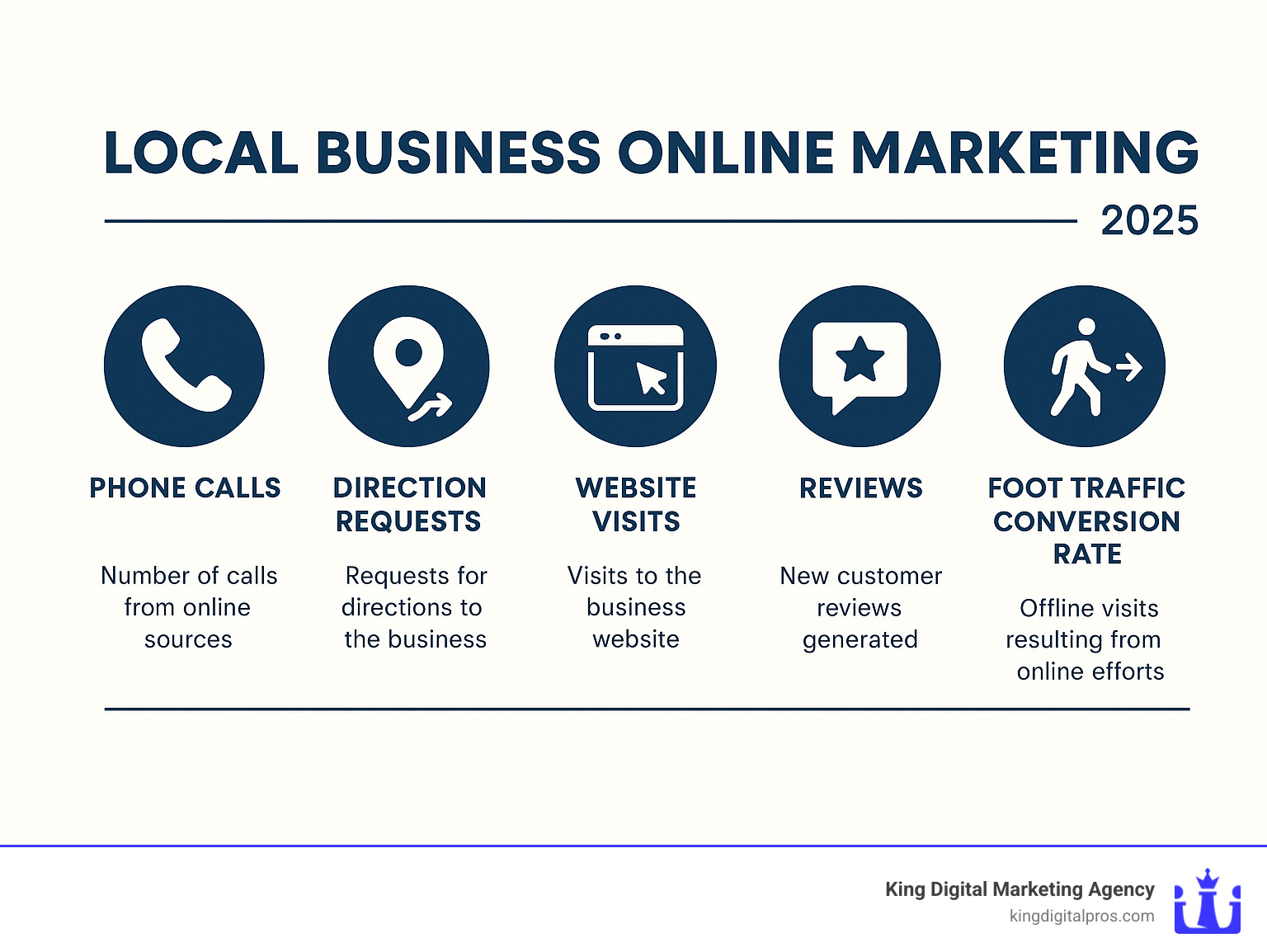
KPIs That Matter Locally
Phone calls from online sources tell you immediately if your digital marketing is working. Use different phone numbers for your website, Google Business Profile, and ads so you know exactly which channel is driving those valuable conversations.
Direction requests through your Google Business Profile are pure gold. These aren’t casual browsers — these are people who’ve decided to visit your location and need to know how to get there.
Review generation rate reveals how well you’re turning happy customers into advocates. Track how many reviews you receive compared to your total customer interactions.
Local search rankings help you understand your visibility trends. More importantly, monitor your map pack rankings — those top three spots that capture most of the local search traffic.
Revenue per visitor connects all your marketing efforts back to actual business results. Calculate how much revenue you generate per website visitor or per person who walks through your door.
More info about Lead Tracking Services
Essential Small-Business Tool Stack
Google Analytics 4 serves as your digital marketing command center, showing you exactly how people interact with your website. Set up conversion tracking for phone calls, contact form submissions, and direction requests.
Google Search Console shows which keywords bring people to your website, how often you appear in search results, and any technical issues that might be hurting your local search performance.
Google My Business Insights provides information about how customers find and interact with your business listing. You can see whether people finded you through direct searches or findy searches.
According to scientific research on mobile user experience, websites that load quickly and work smoothly on mobile devices see significantly better local search rankings and higher customer satisfaction scores.
Outsource vs. In-House Decision
The “should I do this myself or hire someone” question keeps many business owners up at night. Research from the U.S. Small Business Administration shows that 37% of small businesses outsource at least one marketing function, with digital marketing being the most popular choice.
Handling marketing in-house gives you complete control and deep knowledge of your business. The downside? The learning curve is steep, and marketing effectively can easily consume 10–20 hours per week.
Outsourcing to experts gets you immediate access to specialized knowledge and professional tools. You also get to focus on what you do best — running your business and serving customers.
The hybrid approach often works best for local businesses. Handle the day-to-day customer interactions and social media responses internally. Outsource the technical stuff like SEO setup and paid advertising management to professionals.
Frequently Asked Questions about Local Business Online Marketing
How long before I see results?
This depends on what you’re doing and how competitive your local market is. Some tactics work almost immediately while others build momentum over time.
Google Business Profile optimization often shows results within 2-4 weeks. Once you claim your listing, add photos, and start collecting reviews, you’ll typically see increased visibility in local searches pretty quickly.
Paid advertising through Google Local Service Ads or regular PPC can generate leads within days of launch. This makes them perfect for getting immediate visibility while your organic strategies build steam.
Local SEO requires more patience. Significant ranking improvements typically take 3-6 months because Google needs time to trust your website and understand your local relevance.
The smart approach is starting with quick wins like claiming your Google Business Profile and encouraging reviews, while simultaneously working on longer-term strategies like content creation and local SEO.
What budget should I start with?
Most successful local businesses allocate 3-5% of gross revenue to marketing, with at least half going to digital channels. For a business generating $500,000 annually, that means $15,000-25,000 total marketing budget, with $7,500-12,500 for online marketing.
But don’t let those numbers scare you if you’re just starting out. You can begin with a monthly budget of $500-1,000 to cover basic local SEO, Google Business Profile optimization, and limited paid advertising to test what works for your business.
Some of the most effective tactics require time investment rather than money. Creating local content, engaging authentically on social media, and responding thoughtfully to reviews cost mainly your time and effort.
Start small, measure everything, and scale based on what’s actually working for your business.
How do I handle negative reviews?
Negative reviews feel like a punch to the gut, but here’s something that might surprise you: negative reviews, when handled properly, can actually strengthen your reputation.
The key is responding quickly, professionally, and empathetically to every negative review. Acknowledge the customer’s concern, apologize if appropriate, and always offer to resolve the issue offline by providing your direct contact information.
Never argue or get defensive in public responses. Other potential customers are watching how you handle criticism, and they want to see that you care about making things right.
Focus on generating more positive reviews to dilute the impact of negative ones. A business with 50 reviews averaging 4.5 stars appears more trustworthy than one with 5 reviews averaging 5 stars.
Conclusion & Next Steps
Local Business Online Marketing isn’t just a trend – it’s the new reality for small businesses that want to thrive in their communities. The beauty of this shift is that it levels the playing field. You don’t need a massive budget to compete with big chains when you’re focused on serving your neighbors well.
The path forward starts with simple, actionable steps. Claim your Google Business Profile today – it’s free and can start bringing customers to your door within days. Make sure your business name, address, and phone number match exactly across every online platform. Then start that conversation with happy customers about leaving reviews.
Local Business Online Marketing is really about amplifying what you already do best: serving your community. When you focus on genuine relationships and exceptional service, the digital marketing becomes a natural extension of your values rather than a separate challenge.
Your customers are already searching for businesses like yours online. The question isn’t whether you should have an online presence – it’s whether you’ll be found when they’re looking.
At King Digital Marketing Agency, we’ve walked alongside dozens of local business owners through this exact transition. We understand the challenges because we’ve helped solve them. Our expertise in Google Business Profile optimization and local SEO comes from real-world experience helping businesses just like yours attract more customers and grow their revenue.
You have options for moving forward. Some business owners prefer learning and managing everything themselves. Others find their time better spent serving customers while professionals handle the technical details. Many choose a hybrid approach – staying involved in strategy while getting expert help with implementation.
The most important decision is to start somewhere. Perfect is the enemy of good when it comes to local marketing. Your competitors are already claiming their digital territory while you’re thinking about it.
Take one concrete step today. Visit Google My Business and claim your profile. Ask your next satisfied customer for a review. Update your website with your current hours and contact information. Small actions create momentum, and momentum builds success.
Your local community needs what you offer. Make sure they can find you when they’re ready to buy.
The opportunity is there. The tools are available. The only question left is: what will you do with it?
